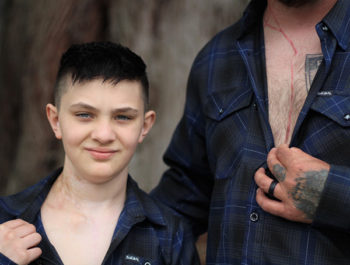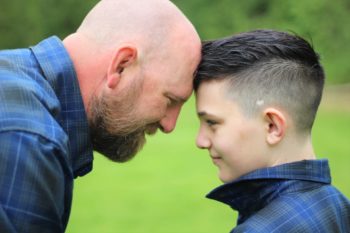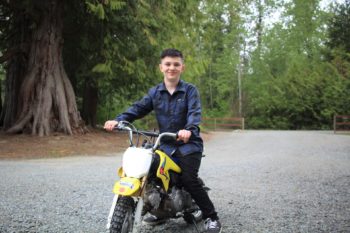
When Ryder Gordon was 2 years old, he underwent his first surgery. It took 12 hours and saved his life.
Thomas Gordon and his wife, Magi, vividly remember the day they handed over their son to surgeons at Seattle Children’s.
“It was gut-wrenching,” said Magi. “You want more than anything to switch places with your child.”
Ryder was the couple’s first child and they never imagined being thrust into a world of comprehensive medical care. But there they were, among the bright lights of the surgical suites and the bustling halls of the hospital.
“Going through a medical journey really humbles you,” added Magi. “Being at Seattle Children’s brought us a sense of comfort. I felt like they cared about us, not just as patients, but as people.”
Seattle Children’s became like a second home. Since Ryder was a toddler, he’s been a patient. Over the years, they’ve walked nearly every hall and corridor of the hospital. Today, he’s 9 years old and has big dreams — and his father has a few more tattoos.
Among the intricate, colorful tattoos is needlework that immortalizes various things that mark his legs, ribs, torso, arms and neck in copious patterns and designs.
The tattoo on Thomas’ neck is the largest of the five and the one he got in solidarity with his son. The pale pink line starts at his neck just under his jawline, descends along his collarbone and traces the fall-line down the middle of his chest. It took the tattoo artist about two hours to complete. It’s an exact replica of a scar to match Ryder’s.
Blindsided by a diagnosis
When Ryder was a toddler, he hit his grandma’s bed and grabbed his shoulder in pain. At first, his parents didn’t think anything of it. Toddlers take their fair share of tumbles and falls, but when his parents took him to the pediatrician to get checked out, they were caught off guard. Something nefarious was lurking just beneath Ryder’s skin.
They were referred to a children’s hospital in Tacoma close to their home for follow-up. Doctors there delivered unimaginable news. They suspected Ryder had tumors.
Imaging showed a large tumor in Ryder’s small body, snaking its way around nerves in his neck and along his spinal cord, heart, shoulder and optic nerve. Ryder was diagnosed with neurofibromatosis type 1 (NF-1). NF-1 is a genetic condition that can cause tumors to grow in the brain, spine, and along a child’s nerves.
Doctors told them their son could suffer a stroke or be paralyzed, so they leapt into action to remove the tumor as soon as possible. They transferred care to Seattle Children’s and met with surgeons to create a plan to remove the tumor.
About 25-50% of children with NF-1 have tumors that grow deep along their nerves, called plexiform neurofibromas. These tumors are benign, but they can cause pain and other issues. NF-1 is present at birth but is often not diagnosed until later in childhood or young adulthood. There is no cure for NF-1, but expert medical care can reduce and manage the effects.
Seattle Children’s has the only pediatric neurofibromatosis program in the region, led by Dr. Aimee Sato, a pediatric neurologist and neuro-oncologist with special training in treating children with NF.
“The tumors can wrap around nerves and compress important structures or vital nerves,” Dr. Sato explained. “Depending on the location, it can be a very serious condition.”
Dr. Sato came to Seattle Children’s about four years ago from Washington, D.C. and trained under a leading neurofibromatosis expert. She enjoys working with families and playing an integral role in helping children who face medical challenges and obstacles thrive.
“You get to know families and have a meaningful, long-term relationship with them,” Dr. Sato said. “I love our kids with NF.”

Children’s NF Program brings together experts in genetics, brain tumors and craniofacial conditions, as well as rehabilitation, physical therapy, occupational therapy, neuropsychology and more. Children with NF require medical care from many subspecialties.
“Kids with NF can have many different complications, so we act as their medical home in neurology and make sure parents don’t have to worry about being an expert in NF and coordinating all of their NF care,” Dr. Sato explained. “We partner with specialists in multiple subspecialties to help manage care in a way that takes the worry off a parent’s shoulders, so they can focus on the important role they play — being a parent.”
Helping with anxiety
After Ryder’s first surgery, an idea sparked in Thomas.
“I wanted him to be comfortable in his own skin,” Thomas said. “It was so hard in the beginning. He wanted us to take his scars off. I just wanted him to know he was okay and to feel normal. I didn’t want him to be embarrassed to take off his shirt. So, I said, ‘I’ll have scars, too.’”
He got his first tattoo three weeks after his son’s surgery. “He was so excited when I showed him,” shared Thomas.
And so, the tradition began to help Ryder feel comfortable in his skin.
Ongoing care
Since that first surgery, Ryder has undergone four other major surgeries.
“Having a skilled surgeon is very important,” explained Dr. Sato. The tumors wrap themselves around nerves and vital structures in the body, so removing them requires immense precision.
Ryder has had many surgeons, but one in particular is his favorite.
Before every appointment with Dr. Jennifer Bauer, chief of spine surgery at Seattle Children’s, Ryder and his family make a special stop to the QFC in University Village, less than a mile down the road from the hospital, where Ryder selects flowers to make a special bouquet for her. It’s a sweet gesture that Dr. Bauer says is the highlight of her whole month.
NF1 can cause a spectrum of complications. For Ryder, his symptoms are on the more severe end. Along with tumors in his body, he also was diagnosed with cervical kyphosis, a rare condition in which his spine was growing backward. Because of the shape of his spine, an abnormal amount of pressure was being placed on his spinal cord, risking nerve injury and causing pain. To fix the abnormality, he needed spine surgery.
“If we didn’t do anything, then his spine was going to continue to grow backwards into his spinal cord,” Jennifer says. “Luckily, we caught it before any injury to his spinal cord occurred. If left untreated, it could have resulted in total paralysis.”
Cervical spinal fusions are incredibly complex. Surgeons at Seattle Children’s treat children in a several-state region and perform about 10 each year. The surgery requires an expert, multidisciplinary team, and Dr. Bauer often works with Dr. Samuel Browd, a neurosurgeon, to do the surgeries together.
Seattle Children’s is nationally recognized as having one of the best orthopedic and neurosurgery programs in the country and is known for treating children with complex spine conditions.
“We have a multidisciplinary team in neurosurgery and orthopedics that work together. And because of that, there’s no aspect of spine care that we’re not able to manage here,” Dr. Bauer said.
During the procedure, Ryder was hooked up to electrodes on his head, arms and legs. The electrodes sent a signal through the spinal cord so the team could make sure the spinal cord was safe during the procedure. They then placed pins into his skull to hold it in place. An incision was made down the middle of the back of the neck, and screws and rods were used to fix the deformity and straighten the spine.
The team then made another incision to remove one of Ryder’s ribs. The rib was used as a graft and to fuse the bones in his neck together.
Ryder recovered quickly from the surgery. Within a week, he was back home.
Soon after, Ryder and Thomas again found their way to the tattoo shop. One tattoo was inked on the back of Thomas’ neck, a mirror to the mark on Ryder. The other was inked on his rib, with letters in script just above the faint pink line: “Riblet.” That’s what the family affectionately nicknamed the rib that was removed, and where a new rib will form.
“Dr. Bauer cared so much about Ryder,” Magi says. “We love her so much!”
Finding confidence
Ryder and his family have a positive outlook on life and live by a simple motto: live life to the fullest.

They hope Ryder won’t need any more surgeries, but if he does, Thomas will continue to get tattoos.
When asked what advice he would give to other kids going through a medical journey, Ryder says, “Be strong.”
“You want to put your kids in bubble wrap,” said Magi. “But you have to let them live.”
Ryder dreams of becoming a motocross racer one day. He admires racers like Eli Tomac and says they are relatable because of everything they put their bodies through. They get injured and have to wear braces or go through a surgery, but they get back on the track and do what they love.
Dr. Bauer hopes that Ryder’s surgeries are just a “blip in their lives.”
“My goal is a year after the surgery, they don’t remember they had surgery,” she said. “I want them to get back to all the things they want to be doing — to just being a kid.”
Emerging research
Dr. Sato said the future for kids with NF is bright. Seattle Children’s is currently involved in many clinical trials for kids with NF and new therapies like MEK inhibitors, oral medications targeting tumors, have changed the lives for many children. For some, surgery is needed.
“We have learned so much, and there is the emerging research that’s going on behind the scenes for NF that is super exciting,” she shared. “We have new therapies and new surgical approaches. We have a better understanding of the cognitive, social and emotional needs of our kids. I think we are definitely feeling like what was accepted as the norm in the past is not necessary the future for kids with NF today. We’re very hopeful these children will have very different lives than adults who currently have NF.”
Resources
- Spine Program – Seattle Children’s (seattlechildrens.org)
- Center for Integrative Brain Research (seattlechildrens.org)
- Center for Clinical and Translational Research (seattlechildrens.org)
- Neurofibromatosis – Seattle Children’s (seattlechildrens.org)

